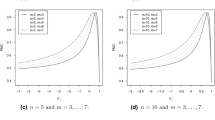Abstract
Increasing competition and volatile conditions in high-tech markets result in shortening product life cycles with non-cyclic demand patterns. This study illustrates the use of a demand-characterisation approach that models the underlying shape of product demands in these markets. In the approach, a Bayesian-update procedure combines the demand projections obtained from historical data with the short-term demand information provided from demand leading indicators. The goal of the Bayesian procedure is to improve the accuracy and reduce the variation of historical data-based demand projections. This paper discusses the implementation experience of the proposed approach at a semiconductor-manufacturing company; the key test results are presented using product families introduced over the last few years with a comparison to real-world benchmark demand forecasts.




Similar content being viewed by others
References
Aytac B and Wu SD (2008). Characterization of demand for short life-cycle technology products. Technical Report 08T-001, Lehigh University.
Bass FM (1969). A new product growth for model consumer durables. Mngt Sci 15: 215–226.
Bewley R and Griffiths WE (2001). A forecasting comparison of classical and Bayesian methods for modelling logistic diffusion. J Forecasting 20: 231–247.
Dickinson JP (1973). Some statistical results in the combination of forecasts. Opl Res Quart 24: 253–260.
Eppen GD and Iyer AV (1997). Improved fashion buying with Bayesian updates. Opns Res 45: 805–819.
Fisher M and Raman A (1996). Reducing the cost of demand uncertainty through accurate response to early sales. Opns Res 44: 87–99.
Fisher M, Hammond JH, Obermeyer WR and Raman A (1994). Making supply meet demand in an uncertain world. Harvard Bus Rev 72: 83–93.
Holden K and Peel DA (1988). Combining economic forecasts. J Opl Res Soc 39: 1005–1010.
Islam T and Meade N (1996). Forecasting the development of the market for business telephones in the UK. J Opl Res Soc 47: 906–918.
Kim H (2003). A Bayesian analysis on the effect of multiple supply options in a quick response environment. Nav Res Logist 50: 937–952.
Kurawarwala AA and Matsuo H (1998). Product growth models for medium-term forecasting of short life cycle products. Technol Forecast Soc 57: 169–196.
Meade N and Islam T (1995). Prediction intervals for growth curve forecasts. J Forecasting 14: 413–430.
Meade N and Islam T (1998). Technological forecasting—Model selection, model stability, and combining models. Mngt Sci 44: 1115–1130.
Meade N and Islam T (2006). Modelling and forecasting the diffusion of innovation—a 25-year review. Int J Forecasting 22: 519–545.
Meixell MJ and Wu SD (2001). Scenario analysis of demand in a technology market using leading indicators. IEEE Trans Semiconduct M 14: 65–75.
Press SJ (2003). Subjective and Objective Bayesian Statistics: Principles, Models, and Applications. J. Wiley and Sons, Inc.: New Jersey.
Quinn T and Mawdsley A (1996). Forecasting Irish inflation: A composite leading indicator. Technical Report 4/RT/96, Central Bank of Ireland.
Sultan F, Farley JU and Lehmann DR (1990). A meta-analysis of applications of diffusion models. J Marketing Res 27: 70–77.
Tang CS, Rajaram K, Alptekinogǧlu A and Ou J (2004). The benefits of advance booking discount programs: Models and analysis. Mngt Sci 50: 465–478.
Timmermann A (2006). Forecast combinations. In: Elliott G, Granger CWJ and Timmermann A (eds). Handbook of Economic Forecasting 2006. North Holland: Amsterdam, pp 135–196.
Winkler RL and Makridakis S (1983). The combination of forecasts. J R Stat Soc 146: 150–157.
Wu SD, Aytac B, Berger RT and Armbruster CA (2006). Managing short life-cycle technology products for Agere Systems. Interfaces 36: 234–247.
Zhu K and Thonemann U (2004). An adaptive forecasting algorithm and inventory policy for products with short life cycles. Nav Res Log 51: 633–653.
Acknowledgements
This research is supported by the Semiconductor Research Corporation grant 2004-OJ-1223.
Author information
Authors and Affiliations
Corresponding author
Rights and permissions
About this article
Cite this article
Aytac, B., Wu, S. Modelling high-tech product life cycles with short-term demand information: a case study. J Oper Res Soc 62, 425–432 (2011). https://doi.org/10.1057/jors.2010.89
Received:
Accepted:
Published:
Issue Date:
DOI: https://doi.org/10.1057/jors.2010.89




